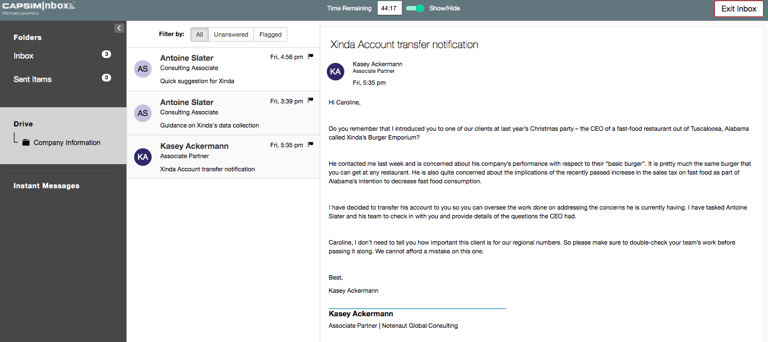Extending Beyond Economics Formulas to Incentivize Critical Thinking
July 20, 2020

Many students find themselves in class directing blank stares at professors, wondering: How can I use this formula after graduation? Will I use this degree in real life?
Before Dr. Christopher Mann joined academia, he owned a couple of businesses. He challenged himself with the kinds of questions he faced as a business owner:
What types of demands were many of his employees facing daily? How did the concepts he talked about relate to everyday business decisions?
When Dr. Mann evaluated the effectiveness of his methodology, he was trying to understand if his students learned concepts they would be able to apply long after graduation.
Uchechukwu Jarrett, Ph.D., and Christopher Mann, Ph.D., colleagues in the Economics department at the University of Nebraska-Lincoln, recognized a challenge in their classrooms. When looking through microeconomics instructional resources, there wasn’t anything available that applied the concepts to the real world.
The ultimate question? How can we make teaching more meaningful?
Students needed experiences that would provide them the opportunity to practice what they learned in theory. While concepts like profit maximization, supply and demand curves, and elasticity were introduced, students weren’t making the connection to how they applied to everyday business decisions.
But that left professors Jarrett and Mann wondering how they could bring learning to life in a classroom setting.
Dr. Tawnya Means, the director of the UNL’s teaching and learning center at the College of Business, first used Capsim for her business strategy classes. When Dr. Jarrett mentioned he wanted to build a simulation for his graduate-level international finance course, Dr. Means reached out to him to see if he would be interested in creating content for CapsimInbox when she was aware of Capsim’s award-winning microsimulation platform. While not the vehicle for the original simulation he had in mind, the benefits of inbox simulations became apparent quickly.
Dr. Jarrett, in turn, reached out to Dr. Mann, a Principles of Microeconomics professor, to partner with him in building an inbox microsimulation.
“Nothing like CapsimInbox existed in the market to provide this particular perspective to students,” Dr. Jarret said.
The two professors teamed up to create a simulation that challenges students with critical thinking. Together, they broke the traditional mold of patterns, formulas, and single correct answers. A new assessment with a more encompassing approach was born.
Choosing CapsimInbox to Launch a Microeconomics Microsimulation
CapsimInbox was used as a way to transform theories into real-world examples. The microsimulation platform empowers students to make business decisions beyond the pages of a textbook. By placing participants in a simulated email environment, situations and decisions are contextualized in a way that’s authentic to the workplace.
The need was in developing content and making it applicable to the real world. How did it come to life?
“I can tell you for certain, that if we went about teaching what we knew in a formulated way, nothing would ever be advanced,” Dr. Jarrett said. “You face new and different situations every day. Your ability to adapt to those situations is critically important.”
These professors were on a mission to bring the need for adaptability and critical thinking to the forefront of their classrooms.
Changing the Approach Toward Assessing Critical Skills
The professors selected the most applicable concepts to everyday business decision-making. Skills evaluated include:
- Market Structures
- Cost and Productivity
- Demand and Supply
- Comparative Advantage
- Profit and Revenue
- Elasticity
- Game Theory
They explored further and asked certain types of questions in nontraditional ways to create an all-encompassing story.
CapsimInbox changes the approach toward understanding and assessing critical skills. It forces learners to think through their responses, enabling instructors to focus on the thought process in selecting an answer, and not necessarily whether or not it is the right answer.
Many times, students guess in multiple-choice scenarios, without having to justify what the response is. With CapsimInbox, instructors gain insights into what the decision-making process looks like in their students’ minds.
CapsimInbox: Microeconomics looks to take theory and introduce application. Every email exchange boils down to decision-making. Should a firm move from one location to another based on the theories of opportunity cost and comparative advantage? Are students able to succeed in competencies such as supply and demand, and elasticity?
The End Goal
“Economics is all about critical thinking,” Dr. Mann said, “and that’s what we’re trying to train.” Ultimately, an economist’s job is to foresee what factors and situations may arise and impact the market.
Authoring the microeconomics simulation helped the University of Nebraska-Lincoln colleagues reassess their teaching methods. “Am I teaching the materials in a way that’s benefiting students once they enter the job market?”
As they evaluate their teaching methods, they continuously challenge themselves to incorporate ideas best to create future business leaders in their students.
Dr. Jarrett is looking for his students to walk away with traits that are more transferable to the workplace than static knowledge from a textbook. He wants his students to clearly understand not only the subject matter of microeconomics but also how students can leverage it moving forward.
His aim for students is to walk away with confidence in making better decisions, and more importantly, apply them to real-world decisions.
“We’re not training mini academics,” Dr. Mann said with a laugh, “but rather, we’re training the next generation of business managers.”
What's Next?
Dr. Jarrett wants to bring interactions between trade and monetary policies among different countries into his classroom. He’ll do so by spearheading the authoring of CapsimInbox: International Economics, once more with his colleague’s help and support.
A few of Dr. Mann’s most significant challenges are transitioning proctor services, office hours, and responding to increasingly lengthier emails from his students in the two online courses he’s teaching this summer.
The next big thing for Dr. Mann? “Trying to survive.” And after surviving, he’ll team up with Dr. Jarrett again to work on a CapsimInbox: Macroeconomics, but this time, he’ll be leading the charge.
Much has changed in the educational landscape. But the colleagues’ partnership remains unwavering amid the uncertainty.
Do you have concepts you want to conceptualize?
Bring them to life with our free microsimulation builder! Check out our free authoring platform today to engage, evaluate and develop your learners in a real-world environment.
Meet the Authors behind CapsimInbox: Microeconomics
Meet Uchechukwu Jarrett and Christopher Mann, Authors of CapsimInbox: Microeconomics and learn how they brought their combined expertise to life.
Getting to Know CapsimInbox: Microeconomics
In this webinar, Dr. Jarrett and Dr. Mann explain why they created their microsimulation, and how participants navigate the role of an Engagement Manager at an economic consulting company specializing in business strategy development.
Check out the webinar to learn more.






.png?width=80&name=1-questions%20(1).png)